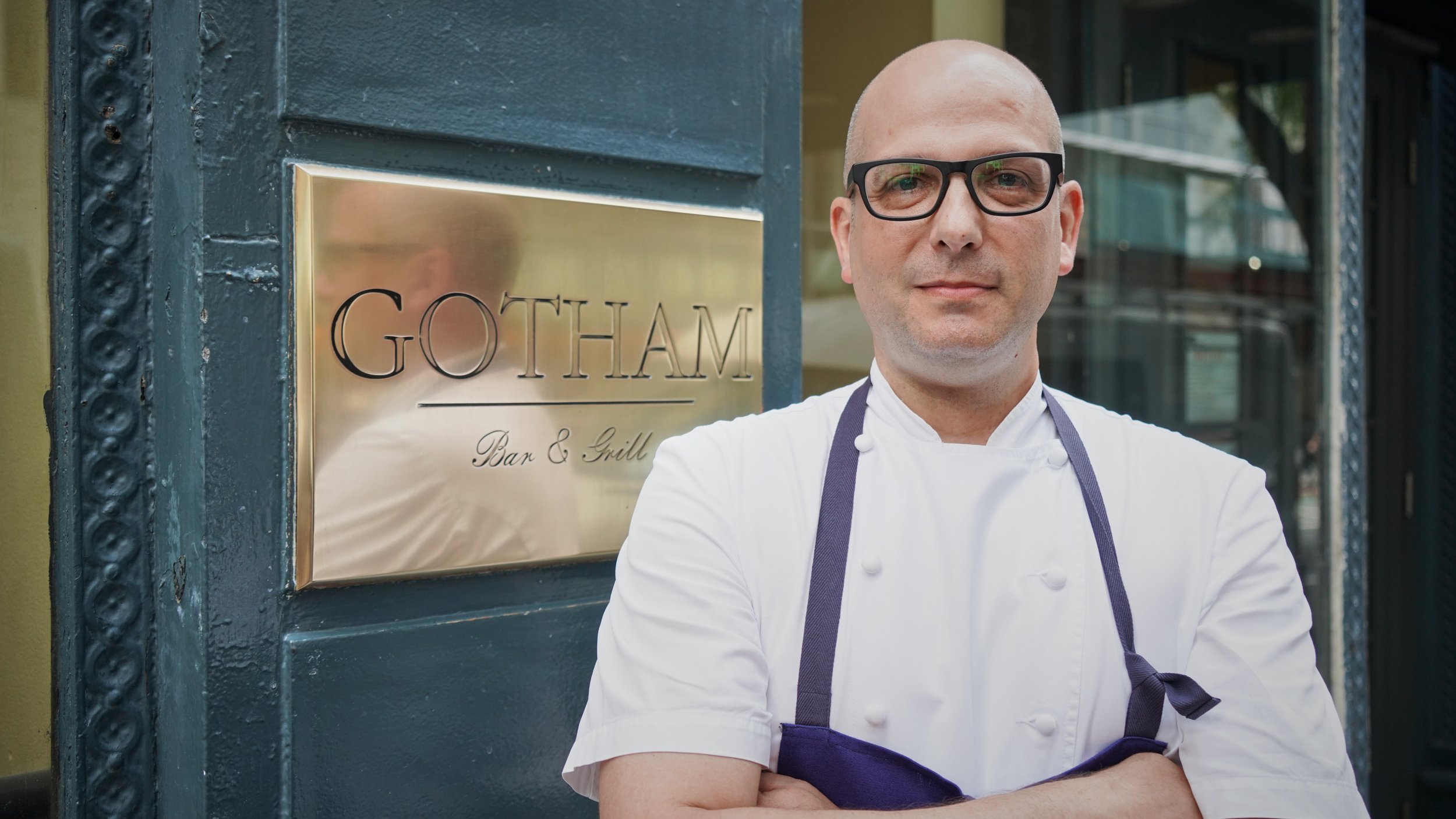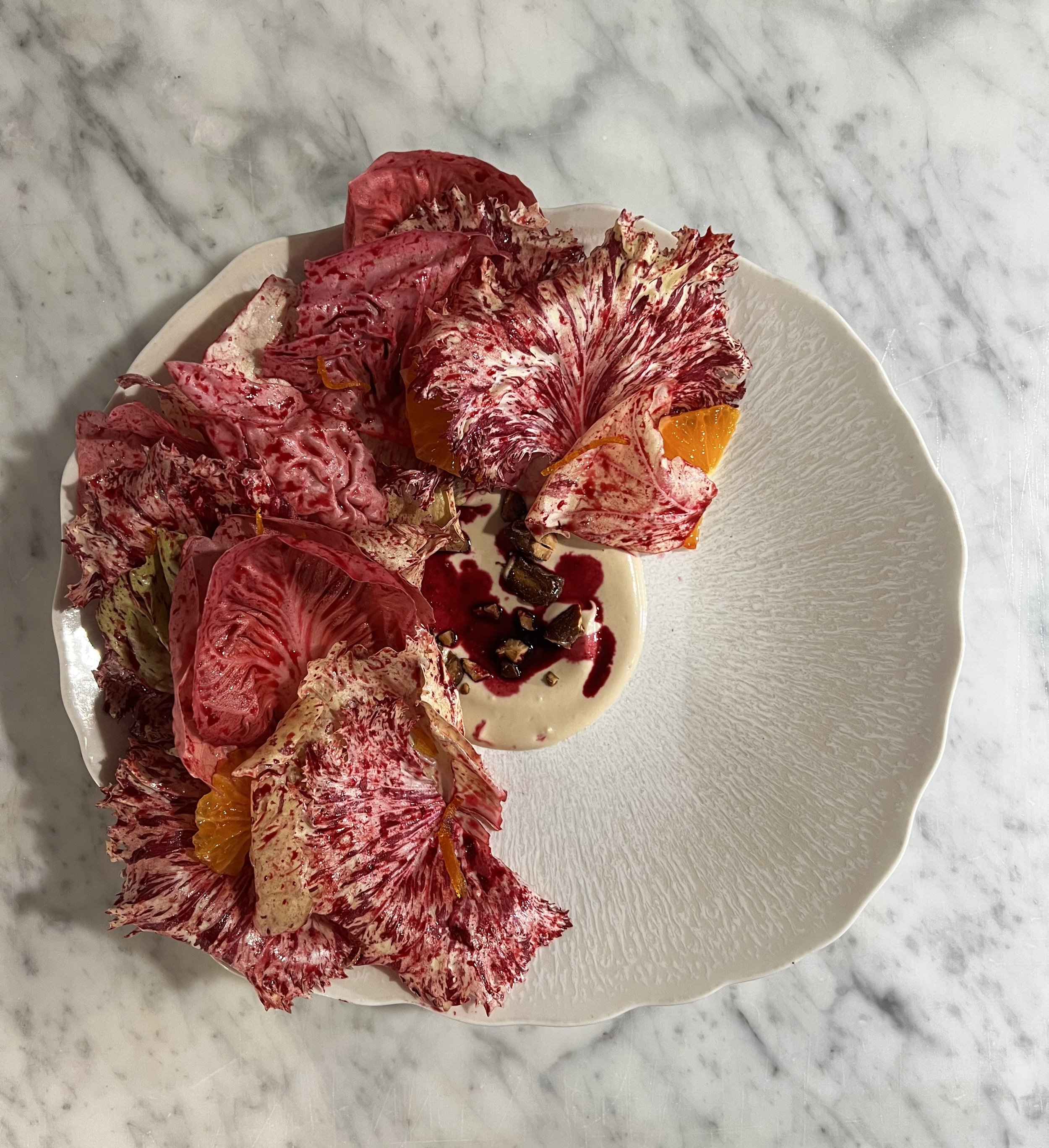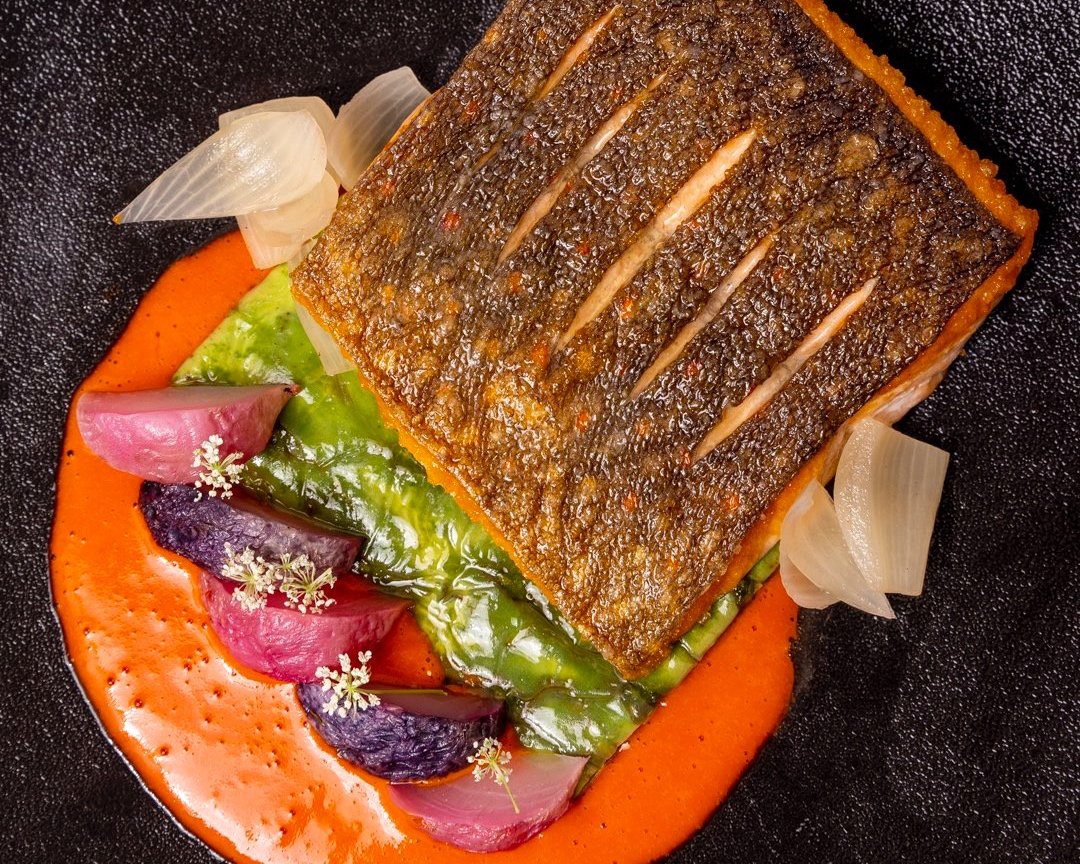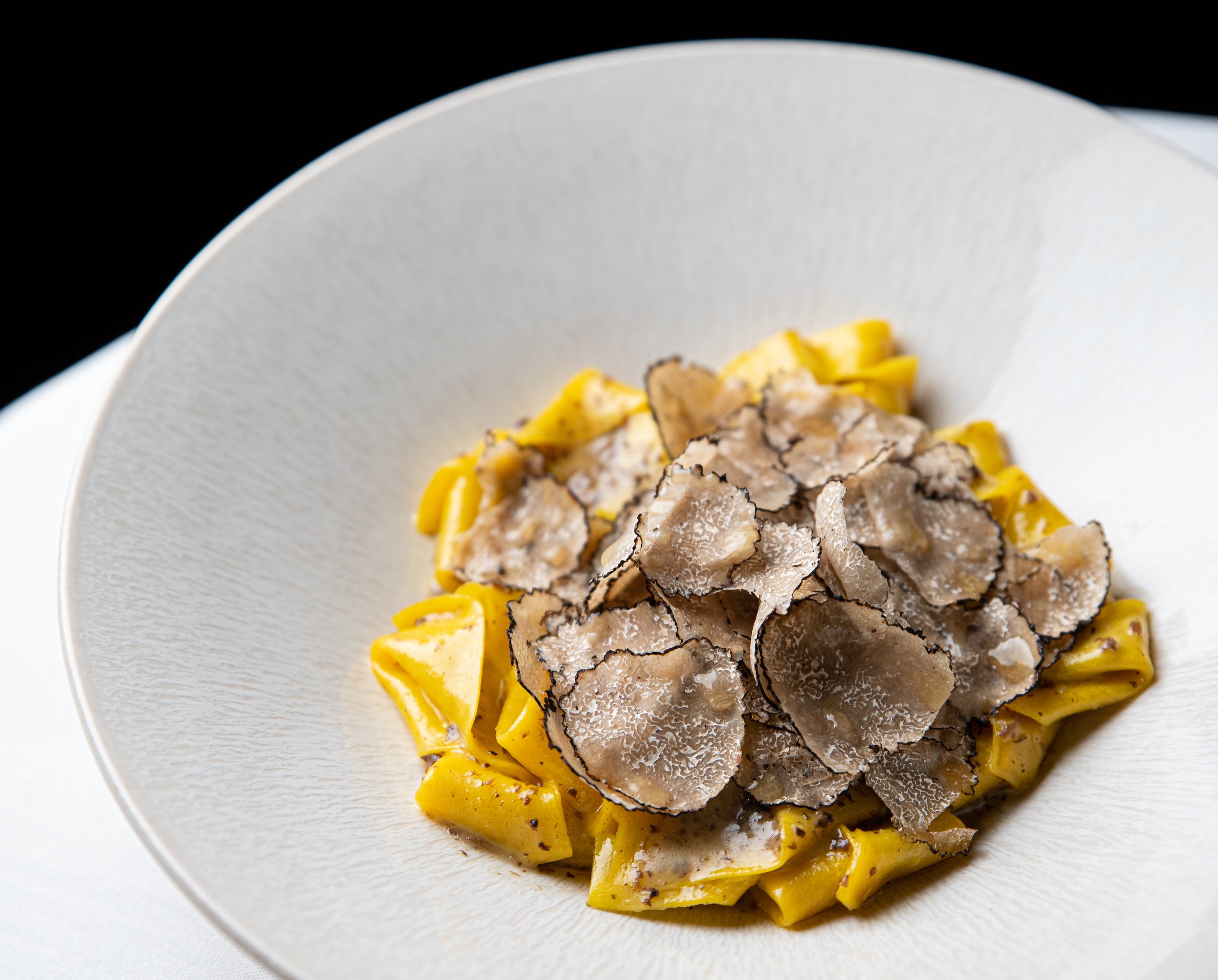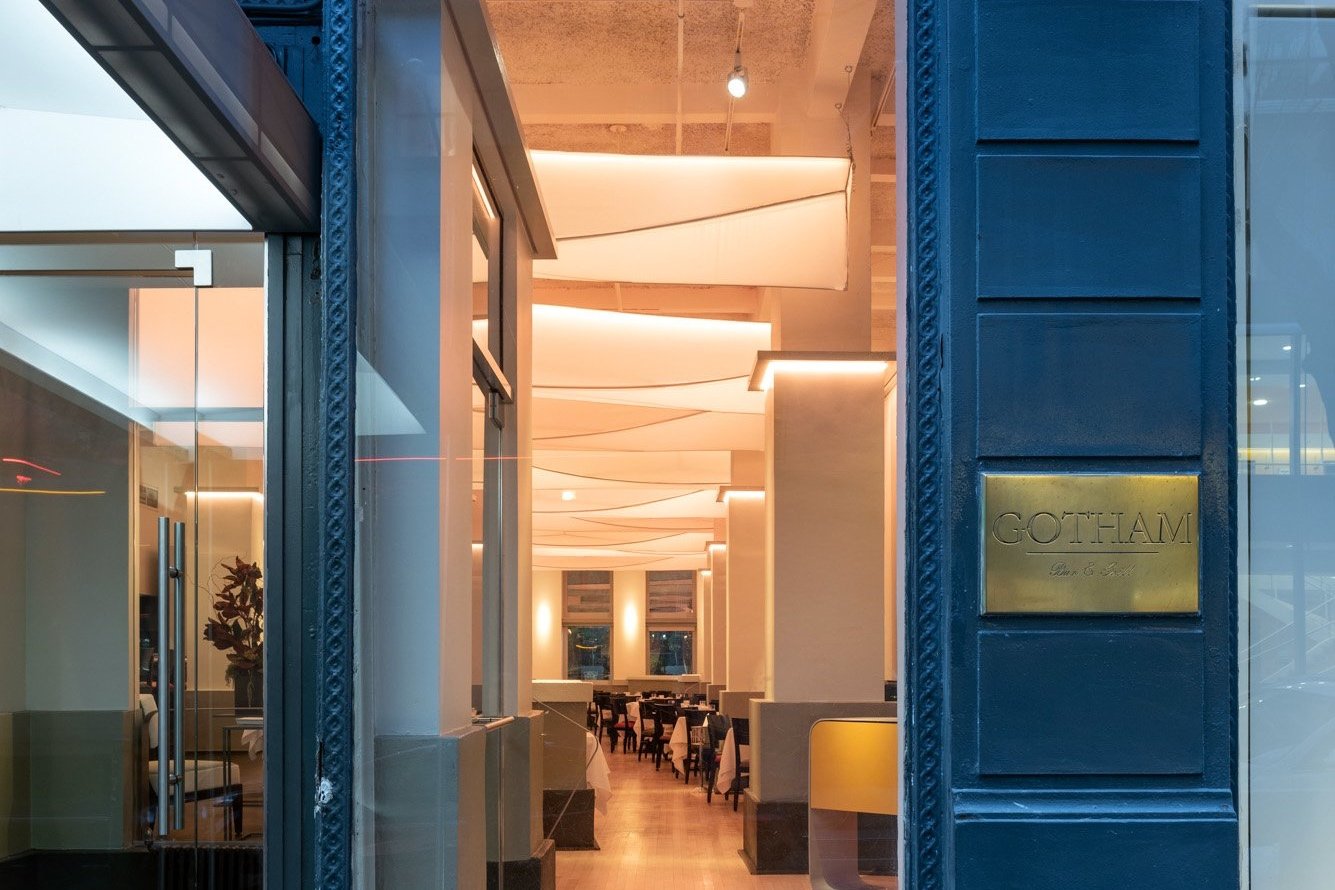Climate Change and the Power Lunch
Ameena Walker profiles Chef Ron Paprocki’s New Gotham Cuisine
Executive Chef Ron Paprocki photographed by Noah Fecks @noahfecksisawesome
By Ameena Walker | Article originally published by OpenTable on February 17, 2023
The managing owner of Manhattan’s Gotham Restaurant talks about greening a classic menu in an age of pandemic and global warming
Gotham on 12th Street in Manhattan, photo by Bret Csencscitz
It has been a crazy few years for restaurants in Manhattan. Some have perished, others have reinvented themselves and thrived. This past week I sat down with Bret Csencscitz, the Managing Owner of Gotham Restaurant in Greenwich Village to find out how a classic institution has pivoted during a time when both the climate crisis and a global pandemic have changed the game on dining out.
PAUL GREENBERG: So, to begin with, tell me a little bit about GothamBEFORE the pandemic. What was the original concept for the restaurant before everything went completely crazy?
BRET CSENCSITZ: Gotham has had several phases and has really traced and led the development of American cuisine over the past four decades, which, if you stop to think about it, has been significant. What Gotham has always maintained, and what we continue today, is a relaxed but elegant ambience with fine food. You can dine here in blue jeans or in a suit. The chief difference now is two things: a renewed commitment to modern cookery and an updated look and feel.
PG: Would it be fair to say, though, back before the pandemic, if you wanted to have a business lunch, ok, a “power lunch,” Gotham would be a choice spot?
BC: Yes, that would be fair statement. In the pre-pandemic world we were a location for many power lunches. Deals were made, agreements solidified and celebratory toasts toasted.
As a citizen we need to think about the future generations and as a business more and more clients want to know where there food comes from and they also want to spend their money at places that are doing their best in regards to environmental issues, including how to address climate change.
PG: What has it been like running a restaurant in the pandemic and post-pandemic era?
BC: The biggest challenge we have is the erratic nature of business nowadays. Two factors are fundamentally different for us: 1) no one dines late anymore. 2) business levels are unreliable. One day we can be very busy and the next day is slow. Primarily, I attribute much of this to the “work-at-home” culture and the fact that people are often able to travel or spend more time in their second homes. Thursday, once our busiest dinner, is now often less busy than Tuesday or Wednesday evenings. There are other factors at play, too. Tourism is not the same and business travel has declined — it is a new reality that we face.
PG: Right. So as you and I discussed over a (delicious) lunch the other day, restaurants are having to tack in different directions. I know, for you, one of those directions is to really look at climate change and the effect food choices can have on reducing a person’s carbon footprint. I’ve spoken at a couple of thematic events you’ve done recently — most recently one celebrating rain forest nations like Gabon that have put in protections to stop deforestation. Can you talk a little bit about the climate pivot you’re trying to make and what you’re trying to do with your menu to fit that new paradigm?
BC: I think it is important for any business, particularly one with a stronger customer facing operation, to consider how their operations effect the community at large. I think it is the responsible thing to do, both as a citizen and as a business. As a citizen we need to think about future generations. As a business, more and more clients want to know where their food comes from and they also want to spend their money at places that are doing their best in regards to environmental issues, including how to address climate change. With our new menu, the chef will take into consideration best practices when sourcing ingredients, how local is it, what type of animal husbandry the producers are practicing, etc. But it is not a static calculus. We like to look at it as incremental progress. We can’t just flip a switch and everything is “right.” We have to make logical, practical decisions that eventually get us to a much better place, and I don’t suspect this will change. We will just keep getting better and better, over time.
PG: So how do you handle that in the “power lunch” context? Customers when they go to a fine dining establishment tend to want to splurge a little. They might have a big carbon intensive steak when they go out whereas at home they might be more willing to swallow the lentil. So how do you square the circle? Do you push lentils or just a better steak?
BC: Well, we don’t have any lentils on the menu currently, so those will have to be swallowed at home. But, yes, it is true many people are looking to splurge. So when we have a steak (not currently on our lunch menu), it will be responsibly sourced and we will understand the practices of where it is coming from. But we also offer some pretty special vegetarian, or even vegan dishes that qualify as splurges. I invite you to come for dinner and try Chef Paprocki’s celeriac dish. It is a roasted celery root served with a bordelaise sauce and black truffles. It is decadent — and vegan (the bordelaise is made with cocoa butter). So, the chef and his team have taken the challenge of creating crave-able cuisine that seeks to satisfy the splurge from all angles. When it comes to lunch, this whole conversation can be had over our Earth Month climate friendly three-course prix-fixe, which is another example of responsible, crave-able and splurge-worthy dining opportunities we offer.
PG: All this is by way of saying that we might need motivations other than “power” to come out to lunch these days. Which actually begs a much bigger question. If offices aren’t ever going to come back to the way they were pre-pandemic, what then becomes the role of the restaurant? Do we dine out to share ideas more than make deals? How does food become part of that new reason for dining out?
BC: We are in a period of “soul-searching” and trying to understand what New York City dining wants to be, particularly given this changed work environment — an environment that will continue to evolve but will probably never return to what it was pre-pandemic. The way we have been approaching it is to have a beautiful environment that is meant to inspire our guests, combined with an ever-changing menu that we hope people want to experience, feel good about it and walk away after lunch restored and empowered. This is all about creating an environment from food to art, to design, that, as you said, is about ideas. I love that, wish I came up with it. But at the end of the day, the food is central and it has to be delicious. And delicious, surprising, fresh — all of that is inspiring.
PG: And perhaps a book or movie deal every once in a while…
BC: Yes, that would be perfect. Both are idea driven.
This radicchio dish was inspired by one of Paprocki’s favorite pandemic foods. Photo credit: Gotham Restaurant
This vibrant dish hasn’t been around long, but it’s already a hit. Paprocki was inspired by one of his pandemic takeout favorites: Alex Stupak’s smoked cashew salsa with chipotle peppers at Empellón.
Paprocki collaborated with his sous chefs, Allen Yonghoon Kim and T.J. Murray, to create a smoked cashew purée that serves as a base for the radicchio. He livens it up with a vinaigrette made with foie gras fat and some citrus (recently Page mandarins), for a rich, sweet-tart sauce.
“The Italian radicchio is something that I’ve been wanting to do for a while because it has a lot of warming elements and different textures that are really interesting,” Paprocki says. “We wanted to kind of push this to create something really neat and not just another boring salad.”
CELERIAC
The crispy celery root is a highlight at the new Gotham. Photo credit: Noah Fecks @noahfecksisawesome.
Paprocki created this dish to meet the needs of vegans and vegetarians. A softball-sized celery root is wrapped in aluminum foil and cooked in the oven for hours until soft. It is sliced into thick discs, pan-seared, and served on a bed of shaved Brussels sprouts and confit Portobello mushrooms. Paprocki drizzles a vegan bordelaise made with cocoa butter on top, along with a few shavings of black truffle.
“It started off as vegetarian and we went one step further to be like, ‘how can we make it vegan?’” Paprocki says. “So we really set out to make a whole dish that’s very hearty, and that we don’t have to glorify or promote as being vegan.”
ARCTIC CHAR
The arctic char is an original Gotham dish that’s been remixed. Photo credit: Matt Taylor-Gross @matt_tg
Paprocki believes his Arctic char has the most unique combination of ingredients on the menu. Chef de Cuisine Sebastián Cacho’s Mexican heritage informed the preparation at Gotham.
The fish is first pan-fried in olive oil, skin-side down, with a simple salt and pepper seasoning. It is then placed on piquillo nage, a sauce made with piquillo peppers that bring a subtle heat to the dish. The fried fish is served alongside seared cactus pads, maitake mushrooms, and trout roe.
“[This dish is] a venture away from the Arctic char we originally offered that was certainly more mainstream and came with a much more expected set,” Paprocki says.
TRUFFLE SOPRESSINI
You won’t find this dish on the menu, but it’s worth asking about. Photo credit: Jason Greenspan @fooderator
This dish isn’t officially on the menu, but it’s worth asking about. The handkerchief-like pasta shape is labor-intensive, so the kitchen prepares it in limited quantities only when there are enough hands on deck.
The pasta is cooked al dente and added to a sauce of chicken stock, butter, and tartufata, an Italian black olive and mushroom sauce. It’s topped with parmesan cheese, shaved black truffle, and a drizzle of brown butter—an umami bomb in a bite.
“The simplicity of this dish is crazy but there’s so many ways to get it wrong and only one way to get it right,” Paprocki says. “[The] flavor really shines and we’ve gotten a lot of compliments on this dish.”
Ameena Walker is an NYC writer and editor covering architecture, food, design, real estate, and culture.

